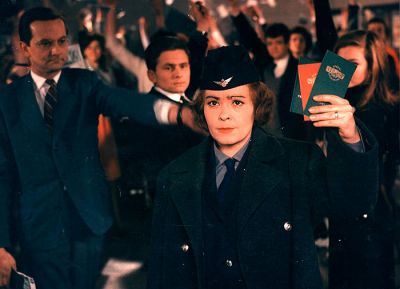
DÁMA NA KOLEJÍCH
(The Lady of the Lines / La signora dei binari, Cecoslovacchia/1966) R.: Ladislav Rychman. D.: 79'
Scen.: Vratislav Blažek, Ladislav Rychman. F.: Josef Hanuš. Scgf.: Oldřich Bosák. Mus.: Jiří Bazant, Vlastimil Hála, Jiří Malásek. Int.: Jiřina Bohdalová (Marie Kučerová), Radoslav Brzobohatý (Václav Kučera), František Peterka (Bedřich Vimr), Libuše Geprtová (Kateřina Vimrová), Stanislav Fišer (signor Marek), Eva Svobodová (Božka Marková), Jan Maška (marito di Božena). Prod.: Filmové studio Barrandov. Pri. pro.: 30 settembre 1966. 35mm. D.: 79'. Col. Versione ceca / Czech version
Da: Národní filmový archiv
Attore, sceneggiatore e regista di film etnografici e documentari su artisti cechi e slovacchi, Ladislav Rychman cominciò a girare film di finzione nel 1956. Creatore del primo musical ceco, Starci na chmelu (1964), due anni dopo realizzò con la stessa squadra di collaboratori un altro film dello stesso genere. La signora dei binari è la storia di una tranviera che fantastica una dolce vendetta nei confronti del marito fedifrago immaginando di scialacquare i risparmi di famiglia faticosamente accumulati per trasformarsi in una signora sofisticata. Lo sceneggiatore Vratislav Blažek scrisse il film su misura per Jirina Bohdalová, attrice di grandissimo talento comico e drammatico che interpretò la frustrata Marie mettendoci tutta la sua personalità.
Il film è quasi interamente ambientato nel mondo creato dalla fantasia della tranviera e il confine tra sogno e realtà non è nettamente delineato. Il ritorno alla vita quotidiana è un finale amaro: solo nei sogni la nostra eroina è riuscita a trasformarsi in una signora e a battersi per riconquistare il marito. La sua piccola tragedia umana è rimasta esattamente tale e quale. Il film si apre e si chiude con l'immagine di suo marito che abbraccia un'altra donna.
Se Starci na chmelu era pensato soprattutto per un pubblico giovane, La signora dei binari si rivolge a una generazione più matura. Il motore della storia sono ancora le canzoni e i balletti, alcuni dei quali girati in esterno a Praga. Ma la musica è più tradizionale e la danza non è strettamente legata alla condotta dei singoli personaggi. Il film è più efficace nei dettagli che nell'insieme. Una scena di grande effetto è quella del 'coro dei vicini' sulle scale del palazzo in cui abita la coppia.
Come nel caso di Starci na chmelu il genere è quello del racconto morale, in questo caso incentrato sulle 'difficoltà della vita di una donna emancipata'. Ma il finale scettico, con il suo rifiuto di concedere allo spettatore la catarsi che si aspetta, fa sì che il secondo film della squadra creativa di Rychman sia messo in ombra dal celebrato predecessore.
Briana Cechová
Originally an actor, screenwriter and director of ethnographic films and documentaries on Czech and Slovak artists, Ladislav Rychman began making features in 1956. As a creator of the first successful Czech musical (The Hop Pickers, 1964), two years later, he led the same team of collaborators to another film in the same genre. The Lady of the Lines tells the story of a married female tram driver, who dreams of sweet vengeance against her cheating husband by imagining herself an elegant lady, who spends painfully accumulated family savings. Screenwriter Vratislav Blažek penned the film specifically for Jirina Bohdalová, an actress of great comedic and dramatic talent who incarnated the character of the frustrated Marie with all the strength of her personality. The film is almost entirely set in Maria's fantasy world, and the passage between dreams and reality is not clearly marked. The eventual return to the everyday comes as a bitter punch line: only within her dream did our heroine change into a lady and manage to fight for her husband. Her small human tragedy is exactly as it was before. The film opens and closes with the image of her husband embracing another woman.
While The Hop Pickers addressed mainly young audiences, The Lady of the Lines turned to an older generation. The story is still propelled by songs and spectacular dance numbers, some of them choreographed on location throughout Prague. But the music is more traditional and the dance is not inseparably linked to the conduct of individual characters. The film is less effective in its entirety than in its details. One particularly impressive scene features the 'neighbor chorus' in the stair- well of our married couple's building. Similarly to The Hop Pickers, we are in the genre of morality, this time focused on the 'difficulties in the life of an emancipated woman'. But the skeptical ending, in its refusal to grant the audience's desire for catharsis, casts the second accomplish- ment of Rychman's creative team into the shadow of its celebrated predecessor.
Briana Cechová

Tariffe:
Aria condizionata
Accesso disabili
Tel. 051 522285











